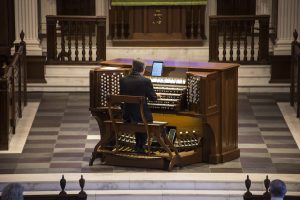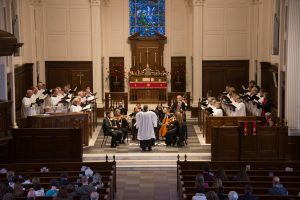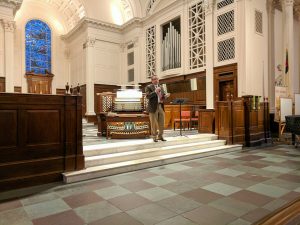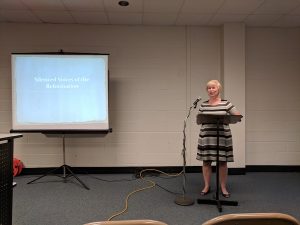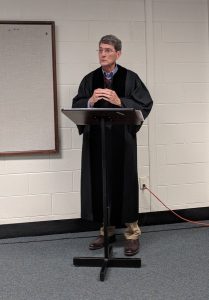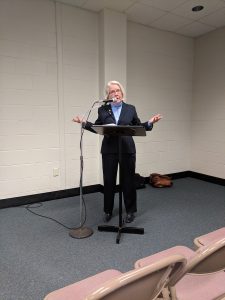The month of October included two works by Bach that stemmed from the Lutheran Reformation.
- On October 22, Alsacian organist, Thierry Mechler, performed Bach’s “Lutheran Organ Mass”. This collection demonstrated Bach’s and compositional skills informed by his theological background. Bach was actually making an important statement with this large-scale work in that it was his first self-published composition for the organ.
- On October 29, our Chancel Choir, sang Bach’s Cantata 80, Ein feste Burg ist unser Gott (A Mighty Fortress is our God) as the main component of our morning worship service. No doubt, there were several hundred other choirs around the world singing that cantata on or around Reformation Sunday this year!
Thomas Cramner (1489-1556)
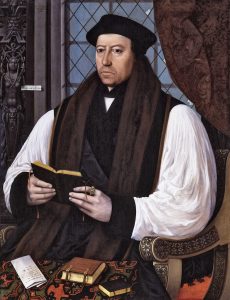 In England, unlike Germany, the Reformation was an act of state, with the first decisive actions taking place in 1532 when King Henry VIII demanded that the clergy submit to the crown. That year, the king also appointed Thomas Cramner as the Archbishop of Canterbury.
In England, unlike Germany, the Reformation was an act of state, with the first decisive actions taking place in 1532 when King Henry VIII demanded that the clergy submit to the crown. That year, the king also appointed Thomas Cramner as the Archbishop of Canterbury.
Thomas Cranmer was not only a theologian, but also a liturgical scholar, a writer. In trying to guide the Church of England from Catholicism to Protestantism, his main concerns were pastoral: he wanted to reform corporate worship and make it more meaningful and accessible for the layperson.
As a result, The Book of Common Prayer was introduced on Pentecost Sunday, 1549. One of Cramner’s main contributions (or detractions) from the worship life of his day was his promotion of – insistence upon – a completely syllabic music style. Florid or melismatic music was out! Latin was out! As a result of these Calvinist values, music in the church had to be radically stripped down.
After Henry’s death, there were violent actions and reactions to the Reformation in England that were not resolved until the reign of Elizabeth I. By that time, Cranmer had done his great work, but he also paid with his life for his faithfulness to his Protestant beliefs. He was executed in 1556, during the short but violent rule of Henry’s Catholic daughter, Mary (ever after known in Protestant lore as “Bloody Mary”). Had he had lived three more years, he would most likely have served under Elizabeth I, whose reign began in 1559.
Thomas Tallis (ca. 1505-1585)
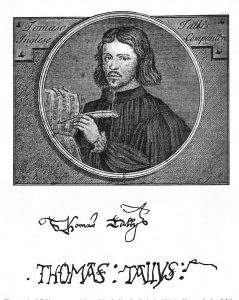 The composer, Thomas Tallis, working at Waltham Abbey, the Chapel Royal, and Canterbury Cathedral. In the anthem/motet collection, English Church Music: Volume I, editor Robert King says it best with his notes to Tallis’s “If ye love me.” “Tallis lived through one of the more turbulent periods of English religious history and needed to write in whatever musical style was required at that moment. For the Protestants in the reign of Edward VI this consisted of simple, syllabic settings with every word clearly audible; for the Catholics under Mary it was complex textures with Latin words; and during the reign of Elizabeth I a musical halfway house emerged where the texts could still be heard but the music could nonetheless remain interesting. It is Tallis’s skill at adapting so naturally to each phrase that shows his consummate musical craftsmanship.” Despite his great service to the Protestant church, he remained a Roman Catholic throughout his life.
The composer, Thomas Tallis, working at Waltham Abbey, the Chapel Royal, and Canterbury Cathedral. In the anthem/motet collection, English Church Music: Volume I, editor Robert King says it best with his notes to Tallis’s “If ye love me.” “Tallis lived through one of the more turbulent periods of English religious history and needed to write in whatever musical style was required at that moment. For the Protestants in the reign of Edward VI this consisted of simple, syllabic settings with every word clearly audible; for the Catholics under Mary it was complex textures with Latin words; and during the reign of Elizabeth I a musical halfway house emerged where the texts could still be heard but the music could nonetheless remain interesting. It is Tallis’s skill at adapting so naturally to each phrase that shows his consummate musical craftsmanship.” Despite his great service to the Protestant church, he remained a Roman Catholic throughout his life.
William Byrd (ca. 1540-1623)
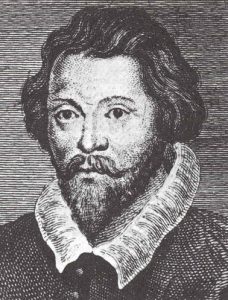 William Byrd was the prize pupil of Thomas Tallis, then the leading figure in the Chapel Royal. He remained very close to Tallis till his death, both personally and professionally. He was employed at Lincoln Cathedral and the Chapel Royal. For the sake of this article, my main interest in William Byrd is how cleverly he managed to straddle the religious and political changes that occurred throughout his lifetime, and how he remained a respected composer despite those changing times. During Protestant rule, Byrd composed excellent anthems in a direct, syllabic style – with English texts. In Catholic times, he wrote motets with beautifully searching melodic lines and harmonies. Byrd was a staunch Roman Catholic (often worshipping in secret), but was generally held in favor by the Protestant regent nonetheless. Still, this did not prevent his home from being placed on a search list at one point. In the end, we are fortunate that Byrd was able to navigate his musical career in such a way that he could produce extraordinary choral music in different styles to inform and inspire us.
William Byrd was the prize pupil of Thomas Tallis, then the leading figure in the Chapel Royal. He remained very close to Tallis till his death, both personally and professionally. He was employed at Lincoln Cathedral and the Chapel Royal. For the sake of this article, my main interest in William Byrd is how cleverly he managed to straddle the religious and political changes that occurred throughout his lifetime, and how he remained a respected composer despite those changing times. During Protestant rule, Byrd composed excellent anthems in a direct, syllabic style – with English texts. In Catholic times, he wrote motets with beautifully searching melodic lines and harmonies. Byrd was a staunch Roman Catholic (often worshipping in secret), but was generally held in favor by the Protestant regent nonetheless. Still, this did not prevent his home from being placed on a search list at one point. In the end, we are fortunate that Byrd was able to navigate his musical career in such a way that he could produce extraordinary choral music in different styles to inform and inspire us.
Written by Bob Gallagher
Originally published in the 2017 Winter Quarterly Explorer
The Chancel Choir is singing J.S. Bach’s Magnificat and Cantata 147, Herz und Mund und Tat und Leben this Sunday, December 10, 2017. Join us for this special concert as we celebrate the Advent and Christmas seasons.
Thoughtful Faith Community (TFC) Celebrates the 500th Anniversary of the Reformation.
- October 11: Bob Gallagher An Introduction to Bach’s Lutheran Organ Mass
- October 18: Pam Durso The Silenced and Muffled Voices of the Reformation
- October 25: Wm. Loyd Allen First Person Monologue of Martin Luther
- November 1: Phyllis Rodgerson Pleasants Tessieri Religious Wars, Inquisitions, Ecumenism, and Irrelevance, Oh My!
- Youth Sunday Night Group What is something the church can do better? (By the way, if you write it, you take responsibility for helping fix the problem you see.)
- Youth Sunday Night Group What is something the church can do better? (By the way, if you write it, you take responsibility for helping fix the problem you see.)
- Thoughtful Faith Community TFC-Kids: Write something you believe about God
- Thoughtful Faith Community TFC-Kids: Write something you believe about God


